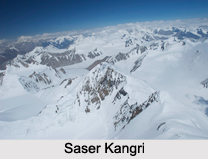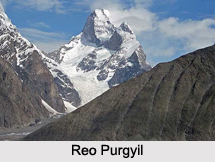 The states of Uttarakhand, Jammu and Kashmir, Himachal Pradesh, Uttar Pradesh and Haryana are located in the northern part of India. North India has several mountain peaks existing as a part of its geographical terrain. They have not only beautified the states in North India, but have also contributed in making this region a tourist destination of India.
The states of Uttarakhand, Jammu and Kashmir, Himachal Pradesh, Uttar Pradesh and Haryana are located in the northern part of India. North India has several mountain peaks existing as a part of its geographical terrain. They have not only beautified the states in North India, but have also contributed in making this region a tourist destination of India.
Mountain Peaks of Uttarakhand
Nanda Devi of Garhwal Himalaya is known to be the highest point of Uttarakhand. It has a height of about 7,816m (25,646ft). Some of the other mountain peaks beautifying Uttarakhand are Abi Gamin (7,355m/24,131ft), Arwa Crest (6,250m/20,505ft), Barmatia (6,041m/19,820ft), Changuch (6,322m/20,741ft), Devtoli (6,788m/ 22,270ft), Hathi Parbat (6,727m /22,070ft), Nanda Ghunti (6,309m/20,699ft) Kamet (25,446 ft / 7,756 m), Nilkantha (21,640 ft / 6,596 m), Yogeshwar (6,678m/21,909 ft), Nanda Pal (6,306m/20,689ft), Sangthang (6,480m/ 21,260ft), Suj Tilla West (6,333m/20,778ft), Suj Tilla East (6,373m/20,909ft), Thalay Sagar (6,904m/22,651ft), Trimukhi Parbat (6,422m/ 21,070 ft), Uja Tirche (6,204m /20,354ft ),Vasuki Parbat (6,792m/ 22,283ft) and Telkot (6,102m/20,020 ft).
Mountain Peaks of Jammu and Kashmir
Saser Kangri is the highest mountain in Kashmir and the 4th highest mountain in India. It has a height of about 25,171 ft (7,672 m). Some of the other mountain peaks of Jammu and Kashmir are Nunkun (20,924 ft / 6,378 m), Stok Kangri (20,187 ft / 6,153 m), Kolahoi (15,768 ft / 4,806 m), Sire Chhish (15,476 ft / 4,717 m), Gutumishungi Chhish (15,220 ft / 4,639 m), Bardum (14,892 ft / 4,539 m), Nichinai (14,643 ft / 4,463 m) and Shin Mahinyu (14,529 ft / 4,429 m), Chinamarg (13,812 ft / 4,210 m), Nurpur Neza (13,832 ft / 4,216 m), Biamocheni Gob (13,854 ft / 4,223 m) and Haramukh (13,879 ft / 4,231 m).
Mountain Peaks of Himachal Pradesh
Reo Purgyil is the highest mountain in Himachal Pradesh and has a height of about 6,816 m. Some of the other mountain peaks of Himachal Pradesh are Manirang (6,597m), Jorkanden (6,473m), Papsura (6,440m), Dibibokri Pyramid (6,400m), Gang Chua (6,288m), Mukar Beh (6,070m), Shipki(6,068m), Sanakdeik Jot (6,045m), Deo Tibba (6,001m), Pir Panjal (5,972m) and Hanuman Tibba (5,860m).
Mountain Peaks of Uttar Pradesh
The state of Uttar Pradesh is beautified by Nagonath, which has an elevation of about 168 meters (551.2 feet).
Mountain Peaks of Haryana
Karoh Peak is the highest mountain peak in Haryana. It has a height of about 1,499m (4,918ft). Some of other mountain peaks of Haryana are Samlasan Devi (2,585 ft / 788 m), Bansgati No 2 (2,552 ft / 778 m) and Khudana (1,564 ft / 477 m).



















